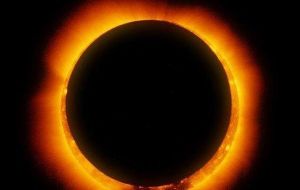MercoPress. South Atlantic News Agency
Antarctica partial eclipse with the moon covering 80% of the sun at South Pole
 The eclipse will be visible at sunrise in South Africa and at sundown in Tasmania and south NZ
The eclipse will be visible at sunrise in South Africa and at sundown in Tasmania and south NZ On Friday, 25 November 2011, a solar eclipse will sweep across the southern part of the world, with the Moon covering about 80% of the Sun at the South Pole, reports the International Astronomical Union, IAU.
Only viewers close enough to Antarctica — in Cape Town, South Africa, near sunrise, and in the Australian island of Tasmania and the South Island of New Zealand near sunset — will be able to see the Sun eclipsed.
Even at its maximum on Earth, the eclipse will be only partial, with some of the everyday sun always visible. The central part of the shadow will pass 330 km below the South Pole; 90% of the Sun will be covered at the part of Antarctica south of Patagonia, South America.
However IAU warns that because the everyday sun is too bright to look at safely, special solar filters or projection methods should always be used to protect the eyes.
Prof. Jay Pasachoff of Williams College in the United States, the Chair of the IAU Working Group on Eclipses, will be viewing his 54th solar eclipse.
He reports that “it is important to view it safely. Special solar filters are available cheaply. Another method of seeing that the Sun is eclipsed is to punch a hole a few millimetres across in a piece of cardboard and hold it up to the Sun while you face away from the Sun and see the Sun's image projected on another piece of cardboard. It is rare that haze or clouds are sufficient to reduce the Sun's intensity enough that one can see a partially covered Sun safely.”
In Cape Town, the eclipse would take place over a period of about 80 minutes an hour after sunrise, from 06.28 to 07.18, with a maximum coverage of 10% of the sun's diameter.
The IAU said partial eclipses were not usually scientifically useful, but the moon's advancing edge could help radio astronomers pinpoint solar storms. This year was unusual because it had only four partial solar eclipses and during all of them the darkest part of the moon's shadow passed over the earth's surface.


Top Comments
Disclaimer & comment rulesCommenting for this story is now closed.
If you have a Facebook account, become a fan and comment on our Facebook Page!